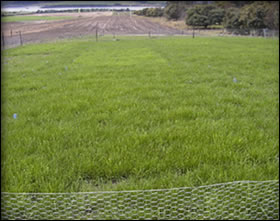 The Scientist: The Scientist:
Lydia Turner BAgrSc(Hons)
School of Agricultural Science,
University of Tasmania, and the Tasmanian Institute of Agricultural Research (TIAR)
Lydia spent the first nine years of her life overseas and has lived in Tasmania ever since. Her family is based on the NW coast and she has just moved back there with her husband after going to university in Hobart, where she did a Bachelor of Agricultural Science with Honours.
She is now nearly half way through a PhD in the area of pasture agronomy at the University of Tasmania’s Cradle Coast Campus. Her project aims to extend current knowledge of the physiology and management of 2 different perennial grass species and to assess their suitability for the dairy industry in southern Australia.
“In the Tasmanian dairy industry today, pastures primarily consist of one perennial grass species, widely regarded as the ‘best’ for the industry. It is likely that other species will prove to be appropriate alternatives in terms of agronomic potential, particularly under dryland management, that is, without a lot of irrigation,” Lydia says.
Her PhD topic came about because a thorough investigation of these alternative grass species is necessary to assess them as potential replacements for perennial ryegrass in the dairy pastures of southern Australia.
Her research is field and glasshouse based, with associated laboratory work, and each experiment takes from 4 months to over a year to complete.
“At school it never crossed my mind to consider Agricultural Science as a potential career, but 2 weeks of work experience in the Primary Industry Placement Programme with a leading pasture agronomy researcher showed me it was a promising option and I haven’t looked back,” Lydia says.
“As a ‘researcher in training’ I love the fact I can find out new things that will really benefit farmers, not only on locally, but potentially on an international level,” she says.
More About the Work:
Key words: Pasture, Perennial ryegrass, Cocksfoot, Prairie grass
The dairy industry in southern Australia is pasture based – which is very different to dairy systems in many other countries, where conditions may force farmers to house cow indoors over winter and feed them alternate food types, or where low feed prices mean it is more economical to feed a large amount of grain.
Perennial ryegrass
In temperate Australia, one grass species called perennial ryegrass has been promoted and accepted as the ‘best’ grass for the dairy industry – usually sown with white clover. However, there are problems associated with using this species in southern Australia, including the inability to survive or grow under dry and/or hot conditions, the requirement for high amounts of water and fertile soils, and the susceptibility to many pathogens and insect pests.
No matter how much more research is done on perennial ryegrass, the fact that the Australian environment isn’t suitable for this species cannot be altered. Even in Tasmania, where we have the highest rainfall in the country, lack of rain during summer means ryegrass becomes dormant without irrigation.
Alternate species
There are alternate species from other parts of the world (i.e. the Mediterranean) that are better suited to the environment here than perennial ryegrass. These include Cocksfoot (also known as Orchardgrass in the Northern Hemisphere) and Prairie grass
The Project
Lydia says “My PhD topic came about because we believe a thorough investigation of these alternative species is necessary to assess the grasses as potential replacements for perennial ryegrass in the dairy pastures of southern Australia. I am investigating the physiology and management of cocksfoot and prairie grass to assess their suitability for use in the dairy industry.”
Grass characteristics (or physiology)
The characteristics of pasture are very important, as they’re closely linked with the amount and quality of milk produced each day (which of course translates to dollars). The characteristics we aim to understand and improve through research include quality (carbohydrates, protein, energy, digestibility, minerals), yield (how much a grass can produce each year and in different seasons), persistence (how long a perennial grass will last as a dense, healthy pasture – will the farmer need to resow a paddock after 2 years or will the grass persist for over 10?), and utilisation (how much of the grass in a paddock is actually eaten and converted into milk).

Structure of a plant

Field study
Management
Management is an important consideration in grass research – particularly for the dairy industry. The three aspects of grazing management are interval (when to graze), intensity (how hard to graze) and duration (how long to graze). Under good management, the yield, quality, persistence and utilisation of a grass species can be maximised – but this requires a clear understanding of how pasture plants grow and what they require for optimal performance. Each grass species calls for a unique set of guidelines in terms of best management, and while these guidelines have already been established for ryegrass, further work is needed for cocksfoot and prairie grass.
Current Studies
These studies are both field and glasshouse based, and include:
- Yield comparison of alternate species with perennial ryegrass
- Quality comparison
- Importance of carbohydrates in regrowth of cocksfoot and prairie grass
- Investigation of 3 species’ response to/recovery from drought conditions
- Animal acceptance/palatability of cocksfoot and prairie grass
- Root patterns during establishment – do they affect speed of establishment?
Websites:
Department of Primary Industry, Water and Environment
https://www.dpiwe.tas.gov.au
Tasmanian Institute of Agricultural Research
https://www.tiar.tas.edu.au
School of Agricultural Science, University of Tasmania
https://www.utas.edu.au/agsci
|
